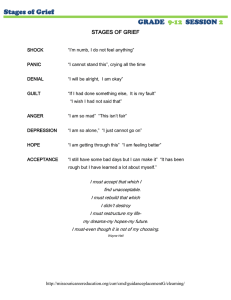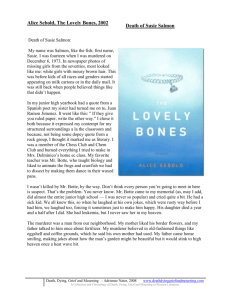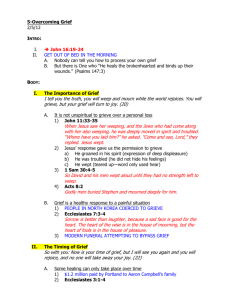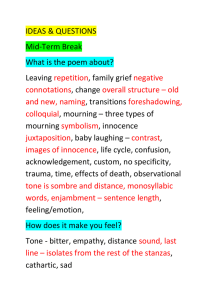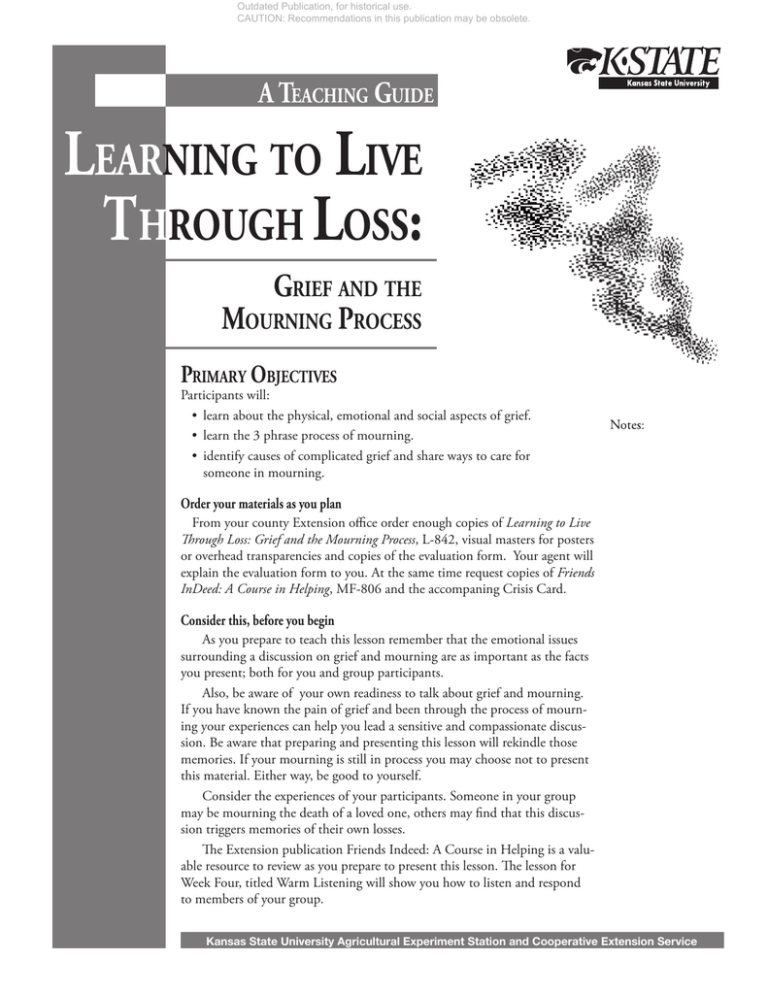
Outdated Publication, for historical use.
CAUTION: Recommendations in this publication may be obsolete.
A TEACHING GUIDE
LEARNING TO LIVE
T HROUGH LOSS:
GRIEF AND THE
MOURNING PROCESS
PRIMARY OBJECTIVES
Participants will:
• learn about the physical, emotional and social aspects of grief.
• learn the 3 phrase process of mourning.
• identify causes of complicated grief and share ways to care for
someone in mourning.
Notes:
Order your materials as you plan
From your county Extension office order enough copies of Learning to Live
Through Loss: Grief and the Mourning Process, L-842, visual masters for posters
or overhead transparencies and copies of the evaluation form. Your agent will
explain the evaluation form to you. At the same time request copies of Friends
InDeed: A Course in Helping, MF-806 and the accompaning Crisis Card.
Consider this, before you begin
As you prepare to teach this lesson remember that the emotional issues
surrounding a discussion on grief and mourning are as important as the facts
you present; both for you and group participants.
Also, be aware of your own readiness to talk about grief and mourning.
If you have known the pain of grief and been through the process of mourning your experiences can help you lead a sensitive and compassionate discussion. Be aware that preparing and presenting this lesson will rekindle those
memories. If your mourning is still in process you may choose not to present
this material. Either way, be good to yourself.
Consider the experiences of your participants. Someone in your group
may be mourning the death of a loved one, others may find that this discussion triggers memories of their own losses.
The Extension publication Friends Indeed: A Course in Helping is a valuable resource to review as you prepare to present this lesson. The lesson for
Week Four, titled Warm Listening will show you how to listen and respond
to members of your group.
Kansas State University Agricultural Experiment Station and Cooperative Extension Service
Outdated Publication, for historical use.
CAUTION: Recommendations in this publication may be obsolete.
TEACHING SUGGESTIONS
On page 3 are activities you may want to use to introduce or
summarize this lesson.
You may choose to follow this outline as you teach this lesson.
Part 1
a. What is grief, what is mourning? (visual 2)
b. Grief
• Importance of grief (visual 3)
• Physical, emotional and social aspects of grief (visual 4)
• Other grief reactions
c. Mourning (visual 5)
• The impact of experience, coping skills, life stresses, spiritual
beliefs, and circle of support on mourning
• Disbelief, shock and numbness as protection (visual 6)
- Anticipated vs. sudden death
- The importance of travel to the funeral
• Reaction to the death
- The value of ritualized grief and mourning
- The needs of mourners after the funeral is over
• Adaptating to the death
- Adaptation is not a matter of time or anniversaries
- Grief spasms
d. Circumstances of the death (visual 7)
• Sudden death
• Traumatic, violent, disfiguring death
• Death of a child
e. Summary
• Grief is the pain, mourning is the process (visual 2)
Depending on the time available, you may either continue with a
discussion on helping and complicated grief and mourning or use the following
outline at a later time.
Part 2
a. How can I help? (visual 8)
• Review phases of mourning (denial, reaction and adaptation)
• Briefly discuss helpful and hurtful responses to grief
experienced by participants
b. Caring during disbelief, shock and numbness
c. Caring during reaction
d. Caring during adaptation
e. Discuss the value of concrete help, and the value of silence
f. Conclude with “Remember that…” from page 6 of the
publication (visual 9)
Allow time for discussion and sharing. Following the lesson, take time to visit
with participants who seemed especially involved in the discussion.
Notes:
Outdated Publication, for historical use.
CAUTION: Recommendations in this publication may be obsolete.
WRAPPING UP
Ask participants to complete the program evaluation which you will return
to your county Extension agent. Plan time for informal discussions after the
lesson is concluded. This may be a good time for refreshments. If participants
want more information refer them to the books listed at the end of this teaching guide. Refer anyone who seems particularly upset to their spiritual leader,
family physician or community mental health center.
SUGGESTED ACTIVITIES TO USE WITH LESSON
You may find these activities helpful to introduce or summarize
the lesson.
Activity 1
Read one or more of these sayings to the group and ask for discussion. As
an introduction, discuss how the verse deals with grief and mourning. As a
summary, discuss how the verse relates to what has been learned. Be prepared
to begin the discussion yourself.
Had we never loved sae kindly,
Had we never loved sae blindly,
Never met—or never parted—
We had ne’er been broken hearted.
Robert Burns
Do not appease your fellow in his hour of anger
Do not comfort him while the dead is still laid out before him;
Do not question him in his hour of misfortune.
Rabbi Simson Ben Ehazer
Home they brought her warrior dead.
She not swooned nor uttered cry;
All her maidens watching said,
She must weep or she will die.
Tennyson, The Princess
No matter what may fill the gap, ev’n if it be filled completely,
it nonetheless remains something else.
Sigmund Freud
Activity 2 (for use with Part 2)
Ask group participants to think about their own experiences with grief and
mourning. Ask them to think about helpful and hurtful things that
were said. Write each of the following statements on a card, mix them up and
ask the group if the statement is helpful or hurtful? Discuss differences of
opinion.
Helpful Statements
“How can I be of help?”
“Tell me how you are feeling.”
“It must be hard to accept.”
“That must be very painful.”
Notes:
Outdated Publication, for historical use.
CAUTION: Recommendations in this publication may be obsolete.
“It’s O.K. to be angry with God.”
“I’m sorry.”
“I wish I could take the pain away.”
Notes:
Hurtful Statements
“It’s God's will.”
“I know how you feel.”
“Time heals all things.”
“She/he led a full life.”
“You will marry again.”
“You can have other children.”
“Your child is in heaven now.”
RESOURCES:
Buscaglia, Leo. The Fall of Freddie the Leaf: A Story of Life for All Ages.
Thorofare, NJ: Charles B. Slack/Book Division, 1982.
Kushner, Harold. When Bad Things Happen to Good People.
New York, NY: Avon Books, 1981.
Loewensohn, Ruth Jean. Survival Handbook for Widows (and for
relatives and friends who want to understand). Glenview, IL:
AARP, Scott, Foresman and Co, 1984.
Rando, Therese A. Grieving: How to Go on Living When Someone You Love Dies.
Lexington: D.C. Heath and Company, 1984.
Sanders, Catherine, M. Grief and the Mourning After. New York,
NY: Wiley Interscience, 1989.
Carolyn S. Wilken, Ph.D.
Extension Specialist
Adult Development and Aging
Brand names appearing in this publication are for product identification purposes only. No endorsement is intended,
nor is criticism implied of similar products not mentioned.
Contents of this publication may be freely reproduced for educational purposes. All other rights reserved. In each case,
credit Carolyn S. Wilken, "Learning to Live Through Loss: Grief and the Mourning Process,"
Kansas State University, December 1991.
GT-317
December 1991
Kansas State University Agricultural Experiment Station and Cooperative Extension Service
It is the policy of Kansas State University Agricultural Experiment Station and Cooperative Extension Service that all persons shall
have equal opportunity and access to its educational programs, services, activities, and materials without regard to race, color, religion,
national origin, sex, age or disability. Kansas State University is an equal opportunity organization. Issued in furtherance of Cooperative
Extension Work, Acts of May 8 and June 30, 1914, as amended. Kansas State University, County Extension Councils, Extension Districts, and United States Department of Agriculture Cooperating, Marc A. Johnson, Director.
File Code: Human Development and Family Relations

